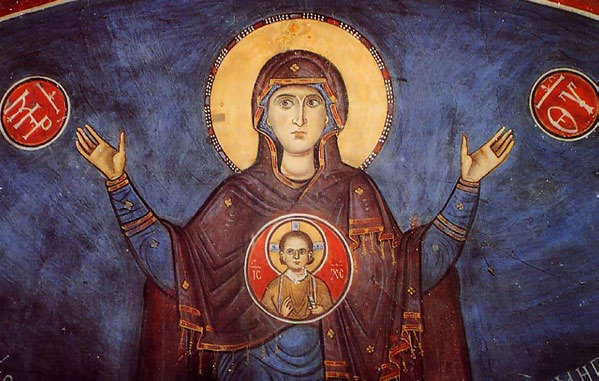Mother of God PANAGHIA PLATYTERA
Publish date 04-04-2024
 In this magnificent 12th century fresco we have a depiction of Mary, Mother of God and Jesus in her womb, according to the ancient model of the Virgin of the Sign, which we have already encountered in the Virgin Panaghia of Jaroslav, most likely the oldest icon of this model (6th century). Also in this case she is represented in the position of the person praying, standing with her arms open and raised towards the sky (a position that characterizes the faithful, those who pray and adore, since the early Christian art of the catacombs), with the circle on her belly in which the child Jesus is depicted, blessing.
In this magnificent 12th century fresco we have a depiction of Mary, Mother of God and Jesus in her womb, according to the ancient model of the Virgin of the Sign, which we have already encountered in the Virgin Panaghia of Jaroslav, most likely the oldest icon of this model (6th century). Also in this case she is represented in the position of the person praying, standing with her arms open and raised towards the sky (a position that characterizes the faithful, those who pray and adore, since the early Christian art of the catacombs), with the circle on her belly in which the child Jesus is depicted, blessing.
However, if there we are on a panel with a gold background, here we find ourselves in a fresco inside a church, on a blue background, which indicates the vastness of the sky, of paradise. She, the Panaghia (i.e. "all holy") therefore also takes the name of Platytera here, that is: wider than the sky.
She who generates and carries within herself the Son of God, the all-holy, all-pure, all-beautiful, the full of grace, becomes the Mother of God and as such, Mother of the Infinite, Mother of the Creator, of Him who the heavens of the heavens cannot contain. Then she herself becomes vaster than the heavens, she becomes heaven itself, infinitely more expansive than the limited physicality of her young body. In fact, in this iconographic image the projection into eternity, outside of space and time, of the people depicted becomes very evident: Mary is young, pregnant and already assumed into heaven, already queen of heaven and earth, and Jesus is small, child but is already in the guise of the Pantocrator, the one who rules the universe.
Mary in her position of abandonment and total self-offering (a position that recalls the open arms of Jesus on the cross) also becomes a model for the church, she who hosts God not to keep him for herself, but to give him, to bring him, to allow him to "radiate" from the center of his person, through which he lives, shines through and gives thanks to the whole world. Mary "contains" Christ within herself, she lives the same life as him, but she too becomes his "carrier". In fact, as is also highlighted by the circle in which Jesus is (very similar to the medallions with the effigy of the Byzantine emperor that his officials or ambassadors wore on official missions) she also has the role, the mission, of bringing Christ to all souls, to all generations, to all peoples and in all times.
Chiara dal Corso
NP Febbraio 2024





